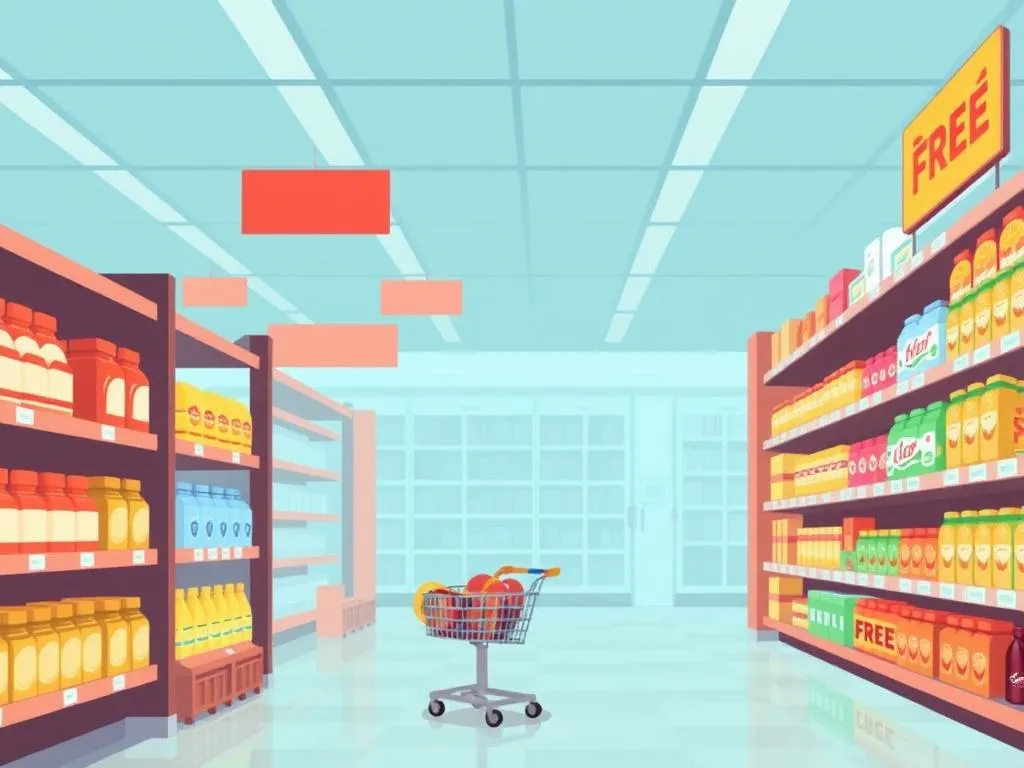Discover the power and examples of Point of Purchase (POP) advertising in our comprehensive guide. Learn about various POP formats, their benefits, and real-world applications to enhance in-store marketing and drive sales effectively.
Point of Purchase (POP) Advertising Examples: A Comprehensive Guide to In-Store Marketing
Point of Purchase (POP) advertising represents a strategic approach to in-store marketing, utilizing promotional materials positioned at or near the point of sale to influence customer purchasing decisions. These displays are designed to capture attention, encourage impulse purchases, and enhance brand visibility within retail environments.
This article provides a thorough examination of POP advertising, detailing its definition, types, benefits, challenges, and real-world applications. Written in a professional yet accessible tone, it aims to equip businesses with the knowledge to leverage POP advertising effectively, ensuring alignment with marketing objectives and customer engagement goals.
Definition and Scope of POP Advertising
Point of Purchase (POP) advertising encompasses promotional materials strategically placed in retail settings to influence customers at the moment they make purchasing decisions. These materials are typically located near checkout counters, product shelves, or other high-traffic areas where customers are most likely to act. POP advertising includes a variety of formats, such as physical displays, signage, and digital screens, each designed to attract attention and drive sales. Unlike traditional advertising, which may focus on broad brand awareness, POP advertising targets immediate action, capitalizing on the customer’s proximity to the point of sale.
The primary objective of POP advertising is to stimulate impulse purchases, promote new or discounted products, and reinforce brand messaging. By leveraging visual appeal and strategic placement, POP displays create a compelling in-store experience that encourages customers to engage with products they might not have otherwise considered.
Importance of POP Advertising
POP advertising plays a critical role in retail marketing due to its ability to influence consumer behavior at a pivotal moment. Its significance is underscored by several factors:
- Immediate Impact: POP displays target customers when they are ready to buy, increasing the likelihood of impulse purchases.
- Enhanced Brand Visibility: Eye-catching displays reinforce brand recognition and differentiate products in competitive retail environments.
- Customer Engagement: Informative and interactive displays provide value by highlighting promotions or product features, enhancing the shopping experience.
- Cost-Effectiveness: Compared to mass media campaigns, POP advertising often requires lower investment while delivering targeted results.
Research suggests that up to 70% of purchasing decisions are made in-store, highlighting the potential of POP advertising to drive sales. For businesses, this makes POP a powerful tool to boost revenue and strengthen customer connections.
Types of POP Advertising
POP advertising encompasses a diverse range of formats, each tailored to specific retail contexts and marketing objectives. The following are the primary types, accompanied by their key characteristics:
Shelf Talkers
- Description: Small signs or tags attached to store shelves, highlighting specific products or promotions.
- Purpose: Draw attention to discounts, new arrivals, or product features.
- Example: A shelf talker in a grocery store promoting a “Buy One, Get One Free” deal on cereal. 🥣
Endcap Displays
- Description: Promotional setups at the end of aisles, showcasing featured products or seasonal items.
- Purpose: Capture attention in high-traffic areas to encourage impulse buys.
- Example: A summer-themed endcap with sunscreen and beach towels in a retail store. 🧴
Floor Graphics
- Description: Adhesive graphics on store floors directing customers to products or promotions.
- Purpose: Guide shoppers to specific areas or highlight special offers.
- Example: Floor arrows leading to a new product section in a department store. 👣
Digital Signage
- Description: Digital screens displaying dynamic content, such as videos or animations, to promote products.
- Purpose: Engage customers with interactive or visually appealing content.
- Example: A touchscreen in an electronics store showcasing a smartphone demo. 📺
Window Displays
- Description: Eye-catching setups in store windows to attract passersby.
- Purpose: Entice potential customers to enter the store.
- Example: A festive holiday window display with gift ideas in a boutique. 🪟
Hanging Signs
- Description: Signs suspended from ceilings to promote products or sales.
- Purpose: Increase visibility across large store areas.
- Example: A hanging banner advertising a clearance sale in a clothing store. 🔖
Dump Bins
- Description: Large bins filled with products, often for clearance or bulk promotions.
- Purpose: Create a sense of value and encourage bulk purchases.
- Example: A bin of discounted snacks near a grocery store checkout. 🗑️
Interactive Kiosks
- Description: Touchscreen displays allowing customers to interact with brand content or make purchases.
- Purpose: Enhance engagement through interactive experiences.
- Example: A kiosk in a tech store letting customers explore product features. 💻
Real-World Examples of POP Advertising
To illustrate the effectiveness of POP advertising, consider the following scenarios:
- Supermarket Checkout Display: A grocery store places a display of candy bars, gum, and magazines near the checkout counter. The colorful packaging and “Grab & Go” signage encourage impulse purchases as customers wait in line. 🍬📰
- Electronics Store Interactive Kiosk: An electronics retailer sets up a touchscreen kiosk where customers can test headphones or watch product demos. The interactive experience leads to increased engagement and sales. 🎧
- Seasonal Endcap Promotion: A department store creates an endcap display for back-to-school supplies, featuring backpacks and notebooks with a “20% Off” sign. The strategic placement at the aisle’s end drives significant sales. 🎒
- Digital Signage in a Mall: A clothing store uses a digital screen to display a looping video of its latest fashion collection, with a QR code linking to an online sale. The dynamic content attracts shoppers and boosts online traffic. 📱
- Window Display for a Boutique: A boutique creates a vibrant window display showcasing holiday gift sets, drawing in passersby with festive decorations and a “Gift Guide” sign. The display increases foot traffic and sales. 🎁
These examples demonstrate how POP advertising leverages strategic placement and visual appeal to influence consumer behavior effectively.
Benefits of POP Advertising
POP advertising offers significant advantages for both businesses and customers, enhancing the retail experience and driving sales.
For Businesses
- Increased Sales: POP displays encourage impulse purchases, with studies indicating that 70% of in-store buying decisions are unplanned.
- Enhanced Brand Visibility: Eye-catching displays reinforce brand recognition and differentiate products in competitive retail environments.
- Targeted Marketing: Displays can be placed near related products to promote cross-selling or upselling opportunities.
- Cost-Effectiveness: Compared to mass media campaigns, POP advertising requires lower investment while delivering targeted results.
For Customers
- Informed Decisions: Displays highlight promotions or product features, helping customers make informed choices.
- Discovery of New Products: POP ads introduce customers to new or discounted items they might not have noticed.
- Enhanced Shopping Experience: Engaging displays make shopping more interactive and enjoyable.
Challenges and Considerations
While POP advertising is highly effective, it presents certain challenges that businesses must address:
- Clutter Risk: Overloading a store with displays can overwhelm customers, reducing effectiveness. Strategic placement and minimalism are key.
- Design Quality: Poorly designed or outdated displays may fail to attract attention or reflect negatively on the brand.
- Maintenance Costs: Digital signage and interactive kiosks require ongoing maintenance, which can increase expenses.
- Customer Perception: Overly aggressive promotions may annoy customers, necessitating a balance between persuasion and subtlety.
To mitigate these challenges, businesses should prioritize high-quality design, strategic placement, and regular updates to maintain customer engagement and brand consistency.
Strategic Implementation
To maximize the impact of POP advertising, businesses should adopt the following best practices:
- Prioritize Visual Appeal: Use vibrant colors, clear fonts, and high-quality graphics to attract attention.
- Strategic Placement: Position displays in high-traffic areas, such as checkout counters or aisle ends, to maximize visibility.
- Align with Customer Interests: Tailor promotions to seasonal trends or customer preferences to enhance relevance.
- Regular Updates: Refresh displays frequently to maintain interest and avoid staleness.
- Leverage Technology: Incorporate digital signage or interactive elements to create immersive experiences.
Future Trends in POP Advertising
The landscape of POP advertising is evolving with technological advancements and changing consumer behaviors. Emerging trends include:
- Augmented Reality (AR): AR-enabled displays allow customers to interact with products virtually, enhancing engagement.
- Personalized Advertising: Data-driven displays tailored to individual customer preferences, such as location-based promotions.
- Sustainable Materials: Eco-friendly displays made from recyclable materials to appeal to environmentally conscious consumers.
- Integration with Mobile Apps: QR codes or NFC tags on displays linking to online content or exclusive offers.
These trends indicate a shift toward more interactive, personalized, and sustainable POP advertising strategies, aligning with modern consumer expectations.
Conclusion
Point of Purchase (POP) advertising is a dynamic and effective marketing strategy that leverages strategic placement and visual appeal to influence consumer behavior at the point of sale. By utilizing formats such as shelf talkers, endcap displays, digital signage, and interactive kiosks, businesses can drive impulse purchases, enhance brand visibility, and improve the shopping experience. While challenges like clutter and maintenance costs exist, strategic implementation and alignment with customer interests can maximize impact.
As technology advances, trends like augmented reality and personalized advertising promise to further elevate POP advertising’s effectiveness. Businesses are encouraged to explore these tools and strategies to create compelling in-store experiences that drive sales and foster customer loyalty.
Sources:
- Point of Purchase Advertising International
- Shopify: Guide to Point of Purchase Displays
- Retail Dive: Trends in In-Store Marketing
Note: This article is for informational purposes only and not professional advice. Verify specific strategies and costs before implementing POP advertising campaigns.








Leave a Reply